Portuguese Possessions in India - July 1954
GOA
Many political organisations were working for liberating Goa, but each one was acting independently. Therefore, an Action Committee was formed in 1953, under Dr. T. B. Cunha, to help the Goans to launch a mass movement. Consequently, on 15th August 1954, three batches of Goan Styagrahis entered in Goa but they were brutally suppressed.
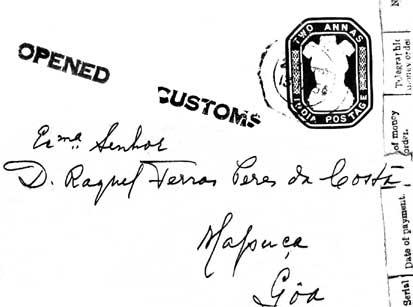 |
By seeing the cover, (dated13th November 1954 addressed to Goa) it appears that the letters coming from India were checked by Custom Department |
The Government of India lodged a strong protest. Once again
on 15th August 1955, 3000 volunteers entered Goa but they 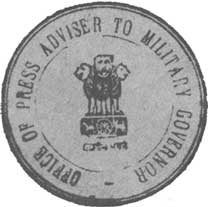 were
butchered by firing by Portuguese forces. The Government of India condemned
the firing by the Portuguese. Thereafter, the Indian Government banned Satyagrahis
to enter in Goa. Cases of torture and terror by Portuguese, were reported
several times in newspapers. In October 1961, the Indian Government declared
that they would think a fresh, because of sad happenings in Goa. Portugal
was adamant and paid no attention to the representation made by USA and Great
Britain to settle the issue of Goa.
were
butchered by firing by Portuguese forces. The Government of India condemned
the firing by the Portuguese. Thereafter, the Indian Government banned Satyagrahis
to enter in Goa. Cases of torture and terror by Portuguese, were reported
several times in newspapers. In October 1961, the Indian Government declared
that they would think a fresh, because of sad happenings in Goa. Portugal
was adamant and paid no attention to the representation made by USA and Great
Britain to settle the issue of Goa.
As no other alternative left with Indian Government, they launched military
action to liberate Goa on 17 - 18th night of December 1961. Goa was liberated
within 36 hours after troops of the 17th Indian Division moved across the
Goan borders. At about 6 AM on 19th December the Portuguese garrison at Panjim,
the capital of Goa, surrendered to Indian forces. The garrison at Daman and
Diu followed suit at 8.20AM and 11.10AM respectively. It was reported that
45 Portuguese and 22 Indian were killed in the lightening army action in Goa.
Major General Kenneth Candeth, Commander of the Indian troops in action, had
assumed charge as military Governor of Goa and its enclaves, on 19th December
1961. Thus Goa, Daman and Diu were liberated on 19th December 1961. In March
1962, Goa Daman and Diu were integrated with India and were made Union Territory
of Goa, Damn & Diu.
The first stamps of Portuguese India found cancelled after 19th December 1961
is of 25th December 1961. The first Indian stamp found cancelled after liberated
is also of 25th December 1961.
 |
 |
It appears that the Portuguese cancellation continued till September
1962. My last example is dated 24th September 1961. Indian cancellation apeeared
for the first time during August 1962. My earliest example is dated 16th August
1962.
It also appears that the cancellations of Goa bears ‘P & T’
in it before normal cancellations were introduced in 1963.
Can anybody slove this riddle - why ‘P &
T’ words inserted in the cancellation?
 |
||
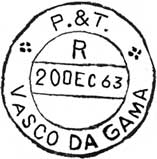 |
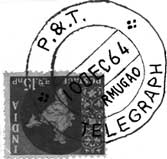 |
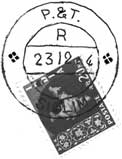 |
Readers are requested to send their query/comments to Mr. Ashok Kumar Bayanwala, 96, Swastik Society,Navarangpura, AHMEDABAD-380009, INDIA or email to Prashant H. Pandya